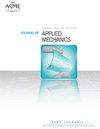A comparative study of the entanglement models toward simulating hyperelastic behaviors
IF 2.8
4区 工程技术
Q2 MECHANICS
引用次数: 0
Abstract
Accurately predicting the hyperelastic response of soft materials under complex loading conditions has been a long-standing challenge. Previous developments have shown that incorporating the entanglement effect can significantly improve the model performance. In this work, we compare the performances of different entanglement models in simulating the stress responses through either fitting uniaxial data alone or uniaxial and equibiaxial data simultaneously. Results show that the entanglement models do not exhibit satisfactory predictive ability with parameters calibrated through uniaxial data. This disadvantage can be overcome through a newly proposed Biot chain model, which inherently incorporates the entanglement effect though a new chain stretch determination that considers the contribution of all surrounding chains. As multiple pairs of experimental data are used to calibrate the model parameter, the Davidson-Goulbourne model provides the best performance. It is also demonstrated that the entanglement effect varies with the deformation mode and plays a more critical role in biaxial deformation than that in the uniaxial deformation. This study can provide a better understanding of entanglement models, including their capabilities and limitations, facilitating the development of more accurate and reliable predictive models toward various applications.模拟超弹性行为的纠缠模型的比较研究
准确预测软材料在复杂载荷条件下的超弹性响应一直是一个长期的挑战。先前的研究表明,引入纠缠效应可以显著提高模型性能。在这项工作中,我们通过单独拟合单轴数据或同时拟合单轴和等轴数据来比较不同纠缠模型在模拟应力响应方面的性能。结果表明,通过单轴数据校准参数,纠缠模型不能表现出令人满意的预测能力。这一缺点可以通过新提出的Biot链模型来克服,该模型通过考虑所有周围链的贡献的新链拉伸确定,固有地结合了纠缠效应。由于使用了多对实验数据来校准模型参数,Davidson Goulburne模型提供了最佳性能。研究还表明,纠缠效应随变形模式的变化而变化,在双轴变形中比在单轴变形中起着更关键的作用。这项研究可以更好地了解纠缠模型,包括它们的能力和局限性,有助于为各种应用开发更准确、更可靠的预测模型。
本文章由计算机程序翻译,如有差异,请以英文原文为准。
求助全文
约1分钟内获得全文
求助全文
来源期刊
CiteScore
4.80
自引率
3.80%
发文量
95
审稿时长
5.8 months
期刊介绍:
All areas of theoretical and applied mechanics including, but not limited to: Aerodynamics; Aeroelasticity; Biomechanics; Boundary layers; Composite materials; Computational mechanics; Constitutive modeling of materials; Dynamics; Elasticity; Experimental mechanics; Flow and fracture; Heat transport in fluid flows; Hydraulics; Impact; Internal flow; Mechanical properties of materials; Mechanics of shocks; Micromechanics; Nanomechanics; Plasticity; Stress analysis; Structures; Thermodynamics of materials and in flowing fluids; Thermo-mechanics; Turbulence; Vibration; Wave propagation

 求助内容:
求助内容: 应助结果提醒方式:
应助结果提醒方式:


